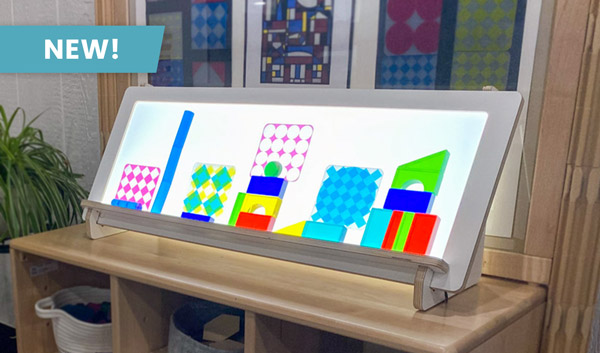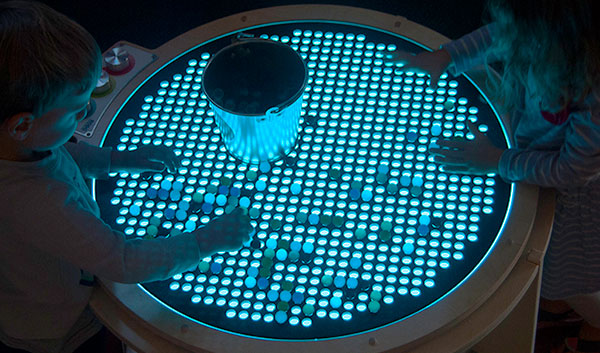Light Exploration
Experimentation with light invites learning about color, pattern, composition, and form. Change and transformation are subjects central to science curricula and are understood by even the youngest learners with tools and materials designed to explore light, silhouette, shadow, and reflection.

Shelf Top Light Panel
This innovative Shelf Top Light Panel turns an ordinary shelving unit into a discovery space! Position it at an upright angle in its frame or remove it from the frame and lay it flat on a shelf or table top. It’s a great small solution for preschool and school age programs!

Light Laboratory
Unlike any other, Kodo’s Light Lab and collection of accessories are designed to engage children in the exploration of light. A removable light panel and abundant play accessories, make the Light Lab just that, a laboratory for experimentation. With years in development the Light Lab is an essential part of every classroom.

Spectrum Light Lab
Designed for higher traffic areas where multiple children will play at once, the Spectrum Light Lab is perfect for libraries, small museums, or common spaces in schools. Shelving and lockable doors provide storage options and both color and white light panels offer children plenty of work space.

Light Panel
Like no other, this light panel produces infinite color combinations as children manually turn dials to add or subtract degrees of red, green, and blue light.

Accessories
Translucent building blocks, rainbow colored pegs, tactile sensory beads, and more are sure to capture attention and spark investigation with Kodo’s Light Labs or your own classroom light tables.
Explore
Light + color
Exploring light as a material enhances sensory play, supports preschool and elementary science curricula, and supports pre-literacy, drawing, writing, and math skills in highly engaging ways. As children explore they increase their attention spans, communicate with peers, work fine motor muscles, and practice hand-to-eye coordination skills.
“The Kodo light table has been a wonderful addition to our play based 4K program. We rotate materials on the light table according to the children’s interests. During the winter months the children learned how to trace snowflake shapes using the light table. We have our light table in an area of the room that allows for small groups of children to have quality interactions with each other.”
Light Laboratory FAQ
Is the Light Lab portable?
Kodo’s color Light Lab Panel comes with your Light Laboratory but is also sold individually. This unit is portable and can be moved from space to space with minimal effort. The entire Light Laboratory can also be moved as space and interests change over time. We recommend that adults remove all the accessories, move the pod, and then return the accessories to their stored positions.
How do children change the colors?
Three control knobs on the Light Lab Panel allow children to mix myriad colors themselves. By turning the knobs they add or subtract degrees of three colors, unlike other light panels which have a predetermined set number of colors and no options for mixing.
How long will the lights last?
The Light Lab Panel features a super bright LED array and has a 10,000 hour bulb life.
Will the Light Lab surface scratch?
We’ve included a screen protector with each Light Lab Panel to protect the panel surface. The screen protector will scratch over time due to normal use and additional screen protectors are available for purchase.
How does play with the Light Lab support my curriculum?
Overall the Light Laboratory supports the objective of supporting children to think scientifically, make observations, inquire, seek answers, and actively investigate the world. Additionally, play with light can support investigations of light and shadow, silhouette, color mixing, rainbows, the sun and sky, natural and manmade light, transparency, and transformation. Look to your curriculum for the inclusion of Light within the natural sciences.

